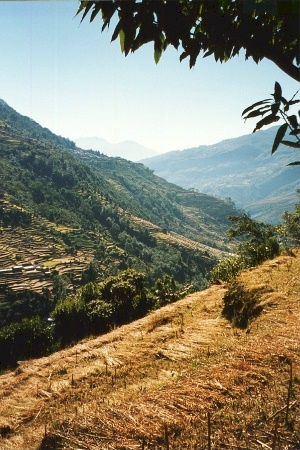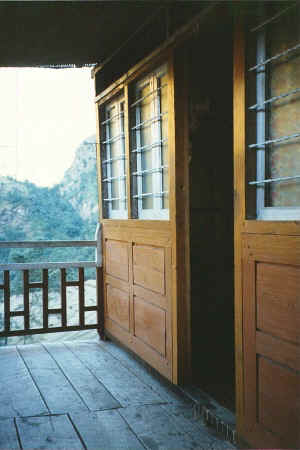Nepal Journal — Friday, 11/22/96
First day on the trail:
From Birethanti (1065m) to Hille (1495m)
A hired driver picks us up after breakfast at the Fish Tail Lodge, and drives us to Birethanti, the closest you can get by car to the Annapurna trail.
The Annapurna trail forms a complete circuit around the Annapurna Massif, a loop that takes three to four weeks to walk. The circuit is usually done counterclockwise, because a very high 5500m pass called Thorung La at the top of the loop is most easily approached from the eastern side. We're only planning to walk about a third of the Annapurna circuit, from Birethanti to a village called Jomsom. Our chosen part of the loop is best done walking clockwise (we'll be walking from, say, 7:00 on a clock dial to 11:00).
We buy some bottled water, shoulder our packs for the first time, and step onto the trail.

Nepalese countryside
After only five minutes, we pass through our first village, the outskirts of Birethanti. A herd of pack ponies are standing in the trail, and we have to push through them. These ponies are used by traders to deliver goods to all the mountain towns and villages inaccessible by road. The weather is quite warm at this low altitude, so another five minutes later, we all have to stop and shed some clothing.
As we pass through the northern end of Birethanti, there's a little excitement as we come to our first police checkpoint on the trail. Their job is to make sure that all trekkers have paid the required fee and obtained a permit. Unfortunately, Mom can't find her permit or Skye's; it appears they may have been left in the car on the drive over. We're afraid our trip will be over before it really start, but luckily, Mom finds the permits, and we go on.
Since we started walking late in the morning, we don't think to stop for lunch until mid-afternoon. The good news is that, on the Annapurna circuit, there are lodges every couple of hours apart, so it's usually not very far to the next meal or bed. We reach the hamlet of Sudame, and stop for a small snack. There are small inns or restaurants all along the trail, maybe an hour to two hours apart, so getting food or bottled water is no problem. The food variety is better than we expected, too. I'd been told by several sources to prepare for a dreary diet of dhal bhat: boiled rice with lentils. One source said you could simulate a dhal bhat diet by pouring boiled pea soup over boiled rice, and then eating this two or three times a day, as the Nepalis do. Luckily for us, my sources seem to have been proven wrong. The establishment we're in serves a small but fairly diverse menu of trekking foods, including potatoes, soups, different kinds of bread, soft drinks, although there is dhal bhat if we're in the mood. (We're not.)

Entrance to our room at our first trekker's lodge
We continue on after our snack, but by this point, the steady climb is wearing us out. We come to a little village called Hille around 4:00 p.m., and decide to call it a day. Our first inn on the trail is called the Mamta Lodge. It's pretty sparse, but typical of the trekking lodges on the trail: there is no electricity, insulation, indoor plumbing, or hot water. Candles provide the light for our dinner, which we eat ravenously. One surprise at dinner: Chris orders a drink off the menu called a "Mustang Coffee", named after the desert-like Mustang region (pronounced Moo-stang) in northern Nepal. He takes one sip, then snaps his head back with a big "Whoa!" It turns out the drink is a local concoction of coffee, sugar, oil, and very strong millet wine. Bleah.
The moon is out, and gives a great nighttime view of the quiet valley--including a solitary fire lighting up a house high up on the opposite hill.